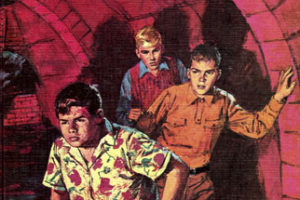
A classic pulp author who has in recent years been forgotten is A. Merritt (1884-1949). Abraham Merritt was an editor who also wrote fantasy tales.
His stories were serialized in the early pulps before being republished as books. Many of his stories were still in print into the 1970s or so, though now mostly out of print.
His most well-known work is “The Moon Pool” (1919). He was influenced by several authors who came before him including H. Rider Haggard, Robert W. Chambers, and Madame Blavatsky. He himself influenced others such as H.P. Lovecraft.
A couple of his works have been adapted into films. Most of his stories are of the “lost world” or “lost race” kind, where a heretofore unknown civilization is discovered in a remote part of the world. But a few are “urban fantasy” stories, where modern-day people are confronted with a fantastical menace in the here and now.
His novels are:
- “The Moon Pool” (1919) This novel combines two shorter stories, “The Moon Pool” (1918) and “Conquest of the Moon Pool” (1919).
- “The Metal Monster” (1920)
- “The Ship of Ishtar” (1924)
- “Seven Footprints to Satan” (1927)
- “The Face in the Abyss” (1931) This combines “The Face in the Abyss” (1923) and “The Snake Mother” (1930).
- “Dwellers in the Mirage” (1932)
- “Burn Witch Burn!” (1932)
- “Creep, Shadow!” (1934)
In addition he wrote several short stories, a few of which have been collected.
As noted, his most well-known work is “The Moon Pool.” It’s still in print from Bison Books and a couple of others. This one is set in the very real and very mysterious ruins of Nan Madol. Nan Madol is known as the “Venice of the Pacific,” a city constructed out a massive amounts of basalt rock on a reef in the Pacific. Who built it and why is unknown.
In the story, we learn that an advanced race of beings lived within the Earth’s core. These beings had created a creature that was supposed to embody both good and evil, but has since turned to evil. This creature is known as the Dweller or the Shining One.
The advanced race is now reduced to three, known as the Silent Ones. They where supposed to destroy the Dweller, but cannot. The Dweller emerges from time to time from the “moon pool” in Nan Madol, to carry off people it imprisons and somehow feed off their life forces.
The hero of the story is Dr. Walter Goodwin, who learns of the Dweller from the survivor of a doomed expedition which was captured by it. Goodwin mounts an expedition with others to enter the Moon Pool and confront the creature and the world below.
Dr. Goodwin returns in the next story, “The Metal Monster,” set in a lost valley of Tibet. There he and his associates must contend with a group of Persians left behind by the campaigns of Alexander the Great. Worse are the metallic beings they find there, ruled over by a mysterious woman. Can they escape, and more importantly, keep these beings in the valley?
 In “The Ship of Ishtar,” the hero, Kenton finds an ancient Babylonian artifact which contains a detailed model of a ship. Somehow he finds himself on this ship, sailing on an eternal sea. On the ship are two groups of people: the assistant priestess of Ishtar and her female minions, and the assistant priest of Nergal and his male minions. They are each segregated to one half of the ship by an invisible barrier, but Kenton is able to pass through it! This changes a balance that has been in place for 6,000 years and froze the ship. What will happen now?
In “The Ship of Ishtar,” the hero, Kenton finds an ancient Babylonian artifact which contains a detailed model of a ship. Somehow he finds himself on this ship, sailing on an eternal sea. On the ship are two groups of people: the assistant priestess of Ishtar and her female minions, and the assistant priest of Nergal and his male minions. They are each segregated to one half of the ship by an invisible barrier, but Kenton is able to pass through it! This changes a balance that has been in place for 6,000 years and froze the ship. What will happen now?
“Seven Footprints to Satan,” one of the few of Merritt’s works adapted to film, is about a young couple kidnapped by a satanic cult. The hero must now play games of chance with Satan. Will he win or lose?
Set in South America, “The Face in the Abyss” tells of a mining engineer who must confront the Lord of Evil imprisoned in a face of gold. He is assisted by The Snake Mother and her handmaiden.
This time set in a lost, heated valley of Alaska inhabited by two races, “The Dwellers in the Mirage” tells of American Leif Langdon who stumbled upon it. The inhabitants worship an evil Kraken they summon from another dimension. Langdon soon fights against this creature.
“Burn, Witch, Burn” is another urban fantasy, where the hero of the story, a doctor, teams up with a mobster to confront sinister dolls controlled by an evil creator. It was adapted into film as “The Devil Doll” (1936), with Lionel Barrymore as the dollmaker.
“Creep, Shadow!” (sometimes called “Creep, Shadow, Creep!”) is a sequel to “Burn, Witch, Burn.” The two main characters from “BWB” are back, but now play secondary roles to the main hero here. They are trying to figure out why several prominent men have committed suicide. We soon find out that someone is working to summon one of the elder gods worshiped in the ancient city of Ys.
Merritt’s work are all worth looking into. As they have fallen into the public domain, it is easy to find them and check them out for yourselves.




First read The Ship of Ishtar back in the 1970’s and fell in love with it. This reminds me to pull my copy of Fantastic Novels off the shelf and read it again.
His short stories can be for the most part found in:
“The Fox Woman & Other Stories” (Avon paperback), some material completed by Hannes Bok
“A. Merritt: Reflections in the Moon Pool” (Oswald Train, 1985), which contains biographical material, poems, essays, an interview, and an unpublished ending for “Dwellers in the Mirage”
and there’s an unfinished novel, which was completed by Hannes Bok
“The Black Wheel” (Avon, paperback)
My personal favourites are “The Moon Pool” and “The Face in the Abyss.”
Tod Browning, who gave us “Dracula” and “Freaks” helmed “Devil-Doll” (It was his penultimate film; “Miracles For Sale” was his cinematic swan song). Erich von Stroheim, his glory days behind him, co- scripted it.
Actually, most of his stories are still under copyright.